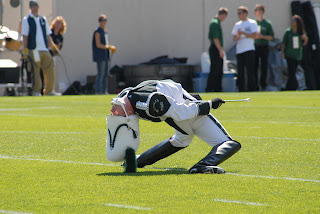
For those of us currently in marching band, keeping our uniforms clean can be a hassle. While the bulk of the uniform (pants and coats) may be dry-cleaned, the extra accessories are usually taken care of by the individual student. Here are some tips I've learned over the years when it come to taking care of a uniform.
First, the shoes. Depending on what type of finish the shoe has, you can either use all-purpose cleaner and may want to invest in some shoe polish. For example, in high school, we marched in MTXs which had a matted finish. For these shoes I preferred using "Kiwi Leather Cuir," not because I like endorsing the brand but because I could buy it on a trip to Wal-Mart. In college, we march in Dinkles. Currently I have no special way to get these super clean other than using some "409" and wiping them down with a paper towel.

Going along with the footwear theme, we come to the spats. Again, "409" works well on a majority of the surface of the spat. However, there is fabric trim on the tops and bottoms. To get these clean you can purchase a handy "Tide-to-Go" pen or any product of that cleaning family. If you're feeling ambitious, you can also hand wash spats in cold water and hang them to dry.

After taking care of your feet, you can move onto the hands. In high school, my band marched with black gloves, and there was no motivation to do any sort of cleaning. At Purdue, white glove are used. To take care of these, throwing them in any load of laundry will work. If you don't want any amount of shrinkage, hand washing them in cold water with a little bit of detergent works just as well.

Still moving up the body, we come to the hat and plume. The hat, like many other parts of the uniform can be cleaned with an all-purpose cleaner and wiped down with a paper towel if the material is water resistant. So far I haven't come across any fabric hats, but for those of you out there who may own one, I recommend the "Tide-to-Go" pen for any small stains. The plumes, on the other hand, can be a bit finicky. The best method I've seen so far is to mix cold water and something like "Woolite" in a small container or bucket and soak the plume. It's best to hang the plume up to dry, but if you're short on time, a blow dryer works just as well. Hopefully these tips help you look your best on the field.
 Marching bands around the nation are all unique organizations, yet music is the single thing that binds them all together. This bond isn't just limited to what these musicians play on the field because, believe it or not, they are ordinary people too. In honor of Halloween, I've look up marching band's relationship to the holiday. The answer is quite simple: Michael Jackson's "Thriller." Whether you love the song or hate it, you have probably heard it a good number of times and know part of the dance. It also seems to be a favorite of many a marching band. The following videos are of select college marching bands who all decided to incorporate the song into their shows. You decide who gave the best performance.
Marching bands around the nation are all unique organizations, yet music is the single thing that binds them all together. This bond isn't just limited to what these musicians play on the field because, believe it or not, they are ordinary people too. In honor of Halloween, I've look up marching band's relationship to the holiday. The answer is quite simple: Michael Jackson's "Thriller." Whether you love the song or hate it, you have probably heard it a good number of times and know part of the dance. It also seems to be a favorite of many a marching band. The following videos are of select college marching bands who all decided to incorporate the song into their shows. You decide who gave the best performance.


































